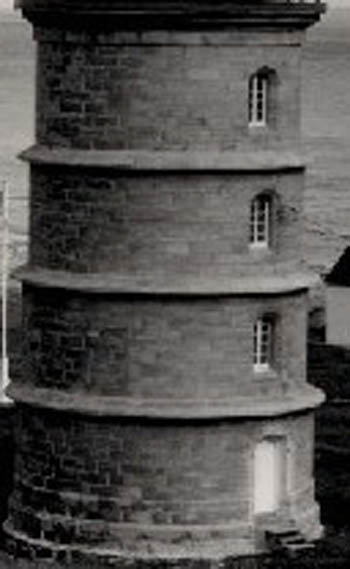Lighthouse
Recognized Federal Heritage Building
Île-Rouge, Quebec

General view
© Transport Canada / Transports Canada, circa/vers 1975.
Address :
Lightstation, Île-Rouge, Quebec
Recognition Statute:
Treasury Board Policy on Management of Real Property
Designation Date:
1988-05-26
Dates:
-
1848 to 1848
(Construction)
Event, Person, Organization:
-
Charles Atherton
(Architect)
Custodian:
Fisheries and Oceans Canada
FHBRO Report Reference:
87-087
DFRP Number:
08204 00
Description of Historic Place
The Lighthouse stands fifty-one feet high (15.5 metres) on the shores of Île Rouge. The structure is a cylindrical masonry tower with a circular cornice, platform and a multi-paned lantern. A decorative iron and rope railing encircles the platform. The tower is clad in smooth, dressed ashlar stone with three evenly spaced stringcourses that give the impression of rings around the tower. Rising vertically above the arched entrance, and within the spacing between the stringcourses, are three Gothic-arched casement windows. The designation is confined to the footprint of the building.
Heritage Value
The Lighthouse is a Recognized Federal Heritage Building because of its historical associations, and its architectural and environmental value.
Historical Value
The Lighthouse is one the best examples of a building associated with Trinity House of Québec, which operated lighthouses in Lower Canada, before Confederation and prior to administration by the Department of Marine to improve safety on the St. Lawrence River.
Architectural Value
The Lighthouse is valued for its very good aesthetic qualities and is a representative example of one of the first cylindrical stone towers built before Confederation by Charles Atherton, the engineer under contract with Trinity House of Québec. Its distinctive exterior openings are common to stone towers of the period. Demonstrating a very good functional design, the building’s walls are lined with brick on the inside and the three stringcourses on the exterior act as weather courses repelling water from the smooth rock surface thus preserving the structure over time. The interior layout reveals that the tower was designed as a self-contained unit for housing the light keeper and his stores. The building is also valued for its construction technique and its excellent craftsmanship, as well as other elements that contribute to its architectural and historical integrity such as the Chanteloupe catoptric apparatus and the decorative iron railing encircling the lantern walk.
Environmental Value
The Lighthouse reinforces the maritime character of its light station setting. It is a familiar landmark in the area.
Sources: Martha Phemister, Île Rouge Lighthouse, Île Rouge, Île Bicquette Lighthouse, Île Bicquette, Pilier de Pierre Lighthouse, Pilier de Pierre, Québec, Federal Heritage Buildings Review Office, Building Report, 87-087, 87-088, 87-091; Lighthouse, Île Rouge, Québec, Heritage Character Statement, 87-087.
Character-Defining Elements
The character-defining elements of the Lighthouse should be respected.
Its good aesthetic and very good functional design, and good craftsmanship and materials, as for example: the height and cylindrical form; the stone masonry construction of smooth, dressed ashlar stone lined with brick on the
inside; the three string courses surrounding the conical shape; the Gothic-arched casement windows and the rounded entranceway; the original Chanteloupe catoptric apparatus and the decorative iron railing encircling the lantern walk; the interior layout.
The manner in which the Lighthouse reinforces the maritime character of its light station setting and is a familiar landmark in the area, as evidenced by: its overall design and materials, which harmonize with its shoreline surroundings and adjacent buildings; its visibility and familiarity as a navigational landmark in the area.
Heritage Character Statement
Disclaimer -
The heritage character statement was developed by FHBRO to explain the reasons for the designation of a federal heritage building and what it is about the building that makes it significant (the heritage character). It is a key reference document for anyone involved in planning interventions to federal heritage buildings and is used by FHBRO in their review of interventions.
The Ile Rouge Lighthouse, 51 feet in height, was built in 1848 to the design
of Charles Atherton, civil engineer under contract to the Trinity House. The building is the property of the Ministry of Transportation. See FHBRO Building Report 87-87.
Reasons for Designation
The Ile Rouge Lighthouse was designated Recognized on the basis that it is one of the best early examples of pre-Confederation stone circular tower of sturdy craftsmanship and design built to improve the navigation of the St. Lawrence River by the Quebec Trinity House, a forerunner of the Department of Marine in lighthouse administration for Lower Canada.
Character Defining Elements
The designation applies to the design of the building, its construction technique and its excellent craftsmanship. The circular gray stone tower is the perfect manifestation of pure functionalism. The building is faced on the outside with smooth dressed ashlar stone which give it a clean finished appearance and lined with brick on the inside. The three string courses surrounding the conical shape act as weather courses repelling water from the rock surface thus preserving the structure over a length of time. The Gothic-arched casement windows and the rounded entranceway are distinctive features common to stone towers of the period. The original Chanteloupe catoptric apparatus and the decorative iron railing encircling the lantern walk are other elements which contribute to the historical integrity of the tower.
The interior layout demonstrates that the tower was designed as a self-contained unit to house keepers and stores. All evidence of the functional layout should be preserved.
Maintenance and repair to the masonry structure should be carried out strictly within the context of the original materials, construction, and pointing techniques.
The reconstruction of a building, evoking in form and spirit the original 1848 dwelling that was once connected to the tower with a covered passageway, would re-establish the original tower-dwelling ensemble. Fences, outbuildings and other features which represent human adaptation to island life should be retained, and reinstated where necessary.